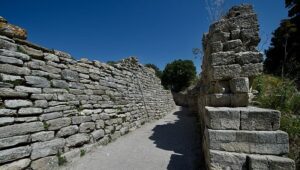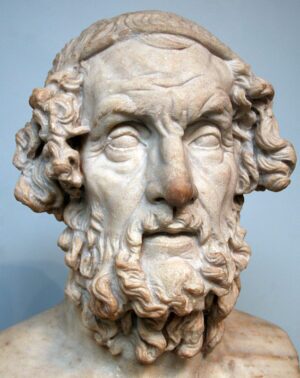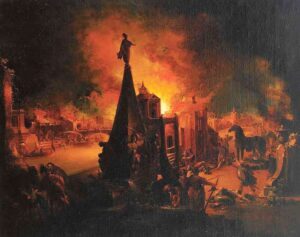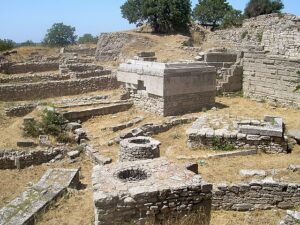
Much has been written about the ancient city of Troy, in both the academic and mythical sense. What follows is a brief interview with Dr. Paul Cartledge, a renowned British ancient historian and academic, answering with his take on Homer and Troy….
___________________________
RM (Richard Marranca):Homer was a bard. Can you tell us what the word “bard” means?

Bust of Homer. British Museum, Public Domain, Wikimedia Commons
PC: Behind Homer lies an unbroken succession of oral poets or bards stretching back probably to the 13th century BCE at least. ‘Bard’ is how we translate Greek aoidos, which literally means ‘singer’ (masculine). A poiêtês (again, masculine) was literally (just) a ‘maker’, a craftsman, rather than an inspired creator or creative.
RM: Could Homer’s Troy be based on some actual place and situation – like competition, a battle, war? And didn’t the Hittites refer to Troy (using a different name) in one of their documents?
PC: Yes, there are Hittite documents of the 13th century referring to a Wilusa – which sounds like the Greeks’ (W)Ilion. And there are other possible linguistic correspondences in the same Hittite records (excavated from their capital at Boghazkoy in central Anatolia not too far from today’s Ankara – and deciphered): e.g., Ahhijawa has suggested to some ‘Achaea’ (Homer never calls Greeks ‘Hellenes’ but ‘Achaeans’ ‘Danaans’ and ‘Argives’), and an individual called Aleksandu may be an equivalent of Greek Alexandros (another name for Homer’s Paris). So, the Hissarlik site [which is identified as Troy by at least some scholars] could have been within the Hittites’ radar – but there’s no corresponding Greek (Linear B) documentary evidence that it was of the Hellenes…
RM: Homer is a real mystery – as is Troy itself. Are the Iliad and the Odyssey by the same author/s?
PC: They are drawn from the same deep well of formulaic epic verse tradition, yes, but only possibly are they by the same master-author/composer, that is, notionally the monumental composer who did a deep dive and came back to the surface with a single theme to unite separately each of the two epics (see above). Experts will tell you that there are differences of not only language but also theological or moral-political outlook between the two, and that may well be so. Experts also themselves differ, not least over the date or dates of the monumental compositions, though most today would I think go for the 8th rather than the 7th (or even 6th) century.
RM: How about the search for what was actual or historical?
PC: As to what was or may have been the – actual, historical – causal nexus or context that underlies the ‘Trojan War’ scenario of the Iliad, it’s perfectly possible to imagine some Greeks coming into conflict with some ‘Trojans’ (northwest Anatolians), perhaps over trade, and just about possible to imagine that the theft of a Greek queen/princess might have been a casus belli, but it’s perfectly impossible to imagine any such trade or diplomatic grievance resulting in… Homer’s Trojan War: ten years’ siege, thousands of fighters and ships involved, most with absolutely no stake of any kind in the successful outcome of such a mega-conflict, etc.
_______________________________

Scene from the Trojan War, as imagined by the painter. Public Domain, Wikimedia Commons
_______________________________
RM: Troy, Homer, Heinrich Schliemann – it’s a bit confusing. Can you shed some light on that?
PC: Scholars today argue the toss as between Troy VIh and VIIa for being ‘Homer’s’ city, on the grounds that they’re both about the ‘right’ date (13th century BCE) for the one besieged by Agamemnon & Co. Regardless, not a trace of evidence has come to light proving, even suggesting, that a Greek siege caused the collapse of either city/level, and there’s general agreement that it was an earthquake or series of them that impacted VIh, anyway. So what Schliemann found – or rather re-found and mostly destroyed – was Homer’s imaginary Troy, not the Trojan War.
RM: So, all those (archaeological) layers – the site of Troy itself – has little relation to Troy? Is there any evidence such as fire and skeletons?
PC: They have every relation to the ‘myth’ of Troy, that is Homer’s imaginary city (cf. the great 2019 British Museum Exhibition ‘Troy – myth and reality’) but little or none to do with — let’s call it ‘the real’ Late Bronze Age site at what in Turkish is now known as Hissarlik! A small cremation cemetery was found outside the walls, associated with the architectural/urban phase archaeologists call VIh (roughly 13th century BCE), but that’s it.
______________________________

Archaeological site of Hissarlik (‘Troy’). CherryX, CC BY-SA 4.0, Wikimedia Commons
______________________________
RM: Can you speak about some of the early archaeology at Troy with Frank Calvert and Heinrich Schliemann?
PC: The catalogue of the B.M. exhibition (noted above) has a superb chapter entitled ‘Archaeological Troy’. There the names of Robert Wood and Charles Maclaren, among many others, are given their due alongside Frank Calvert – as necessary predecessors of Schliemann and his bandits — sorry, team of excavators. Prussian (eastern German) businessman Schliemann set out to prove that Homer was not only an epic poet but in effect a historian, and he did find a site that already the ancient Greeks had identified as Homer’s Troy – they named their new 8th-century settlement nearby Ilion or New Ilion.
RM: Did Schliemann do damage to the site?

Heinrich Schliemann, Ed. Schultze Hofphotograph Heidelberg Plöckstrasse 79, Public Domain, Wikimedia Commons
PC: As to ‘excavation’, well, what Schliemann did beggars the imagination. Driving trenches across and through the tell resulted in incalculable destruction and loss of both artefacts and information. And predictably, Schliemann soon proved himself to be more of a treasure-hunter than archaeologist properly so called, decking out his teenage Greek bride Sophia in what he of course called the jewellery of Helen’.
______________________________
RM: And what about that famous mask that he found?
PC: As to the gold so-called ‘mask of Agamemnon’ (found at one of the other major Bronze Age sites he had ‘excavated’, Mycenae in the Peloponnese of mainland Greece), that was several hundred years too old to be the death-mask of any real, historical ‘Agamemnon’, supposing there ever had been any such regal figure.
______________________________

The Mask of Agamemnon. Gautier Poupeau, Public Domain, Wikimedia Commons
______________________________
Cover Image, Top Left: Sections of the walls of Hissarlik, or ‘Troy’. Dosseman, CC BY-SA 4.0, Wikimedia Commons
Advertisement




